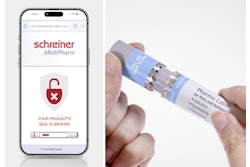If passed in the Senate this year as expected, Pharmaceutical Market Access & Drug Safety Act (H.R. 700/S. 334) could clear the way for drugs manufactured in the United States, and then exported, or drugs manufactured in developed countries in Europe, Canada and elsewhere, to be reimported back into the U.S., so long as the importer can verify the drug package's chain of custody. Radio-frequency identification (RFID) tags can satisfy that requirement.
Several drug companies have or are pilot testing such tags for packaged drugs. New York-based Pfizer Inc.'s director of trade product integrity, Peggy Staver, says the firm will tag 30- and 100-count bottles of Viagra sold in the U.S. by the end of 2005. Pfizer is considering the use of 13.56-MHz high-frequency tags on bottles and UHF tags on cases and pallets of Viagra.
According to Staver, pharmacies have expressed interest in gaining additional experience with 13.56-MHz tags in their pharmacy settings, while the UHF tags are more appealing to wholesale distributors who are dealing with greater read ranges in warehouse environments.
Because of the small size of those bottles, Pfizer will probably find itself in the same position as Purdue Pharma L.P., Stamford, CT, which had to use UHF Class 0 EPCglobal tags on bottles of OxyContin and Palladone. Purdue Pharma is putting 915-MHz tags on bottles of those two opiate pain medications. Class 1 tags, which have more functionality, were available, says Dave Richiger, Purdue Pharma's executive director, package design and development, but they were not small enough to fit on the bottles.
The use of Class 0 tags poses some problems: Data has to be programmed into the RFID chips in Asia where they are manufactured. The chips then travel through Europe, where antennas are affixed and the tags receive final processing before they arrive at Purdue's facilities in the U.S., where the tags are affixed to bottles, lengthening the supply chain.
"Our next step is installing additional capacity on our packaging lines so we can tag cases and pallets," explains Richiger. "We need to purchase antennas and readers that can interface with our enterprise resource planning system."
The Food and Drug Administration has encouraged the adoption of RFID tagging via a Compliance Policy it published last November. That policy allows drug companies to undertake "pilot projects." The FDA is mainly concerned that radio-frequency energy from RFID tags does not degrade the drug quality, primarily from heating the drug mixture.
--By Stephen Barlas, Contributing Editor
Several drug companies have or are pilot testing such tags for packaged drugs. New York-based Pfizer Inc.'s director of trade product integrity, Peggy Staver, says the firm will tag 30- and 100-count bottles of Viagra sold in the U.S. by the end of 2005. Pfizer is considering the use of 13.56-MHz high-frequency tags on bottles and UHF tags on cases and pallets of Viagra.
According to Staver, pharmacies have expressed interest in gaining additional experience with 13.56-MHz tags in their pharmacy settings, while the UHF tags are more appealing to wholesale distributors who are dealing with greater read ranges in warehouse environments.
Because of the small size of those bottles, Pfizer will probably find itself in the same position as Purdue Pharma L.P., Stamford, CT, which had to use UHF Class 0 EPCglobal tags on bottles of OxyContin and Palladone. Purdue Pharma is putting 915-MHz tags on bottles of those two opiate pain medications. Class 1 tags, which have more functionality, were available, says Dave Richiger, Purdue Pharma's executive director, package design and development, but they were not small enough to fit on the bottles.
The use of Class 0 tags poses some problems: Data has to be programmed into the RFID chips in Asia where they are manufactured. The chips then travel through Europe, where antennas are affixed and the tags receive final processing before they arrive at Purdue's facilities in the U.S., where the tags are affixed to bottles, lengthening the supply chain.
"Our next step is installing additional capacity on our packaging lines so we can tag cases and pallets," explains Richiger. "We need to purchase antennas and readers that can interface with our enterprise resource planning system."
The Food and Drug Administration has encouraged the adoption of RFID tagging via a Compliance Policy it published last November. That policy allows drug companies to undertake "pilot projects." The FDA is mainly concerned that radio-frequency energy from RFID tags does not degrade the drug quality, primarily from heating the drug mixture.
--By Stephen Barlas, Contributing Editor


















